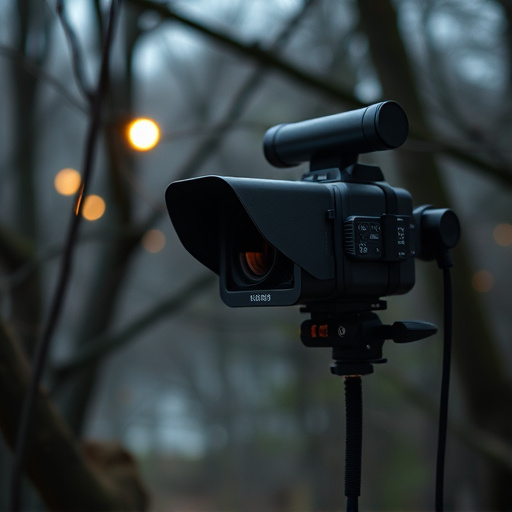Micro cameras, disguised in everyday items, offer parents advanced monitoring features for child safety without disrupting routines. To secure a network for these cameras, set up a high-performance router with strong encryption, connect cameras via Ethernet to a dedicated VLAN, implement firewall rules, and encrypt communication using TLS/SSL. Best practices include discreet placement, regular updates, robust passwords, 2FA, and unique credentials for each device, ensuring effective child protection while maintaining privacy.
Protecting your child’s safety has never been easier with micro cameras for child protection. These tiny yet powerful devices offer a discreet way to monitor their well-being, both at home and on-the-go. In this comprehensive guide, we’ll walk you through setting up a wireless hidden camera network, from understanding the technology behind micro cameras to maintaining your privacy. Discover essential components, follow our step-by-step instructions, and learn best practices for keeping your child safe with minimal intrusion.
- Understanding Micro Cameras for Child Safety
- Components of a Wireless Hidden Camera Network
- Setting Up Your Secure Network: Step-by-Step Guide
- Best Practices and Tips for Maintaining Privacy
Understanding Micro Cameras for Child Safety
Micro cameras, also known as hidden or nano cameras, offer a discrete and effective solution for child safety. These tiny yet powerful devices are designed to fit seamlessly into everyday objects like toys, potted plants, or even wall sockets, making them ideal for monitoring children’s activities while they play or explore. With advanced features such as motion detection, night vision, and remote access via smartphones, micro cameras provide parents with a sense of security and peace of mind.
For parents seeking to protect their children, micro cameras serve as an innovative tool. They allow parents to keep an eye on their kids’ surroundings without compromising privacy or disrupting their normal activities. By setting up a network of these hidden cameras, families can ensure child safety in various locations, from playrooms at home to outdoor spaces, enhancing overall security and well-being.
Components of a Wireless Hidden Camera Network
Setting up a wireless hidden camera network involves several key components designed to ensure seamless surveillance and peace of mind, especially when prioritizing child protection. At the heart of this system are micro cameras—discreet devices that capture high-resolution footage, allowing parents or caregivers to monitor activities within their home. These tiny yet powerful cameras are often equipped with wireless capabilities, enabling real-time transmission of video feeds to a central control unit or mobile device.
To complete the setup, you’ll need a base station or router that acts as the hub for wireless communication. This device facilitates the connection between all hidden cameras and ensures stable data transfer. Additionally, cloud storage plays a crucial role in preserving footage, making it easily accessible at any time. When configured correctly, these components work together to create an efficient network, providing comprehensive coverage for child protection purposes while maintaining a level of discretion.
Setting Up Your Secure Network: Step-by-Step Guide
Setting up a secure network for your micro cameras is crucial for effective child protection. Here’s a step-by-step guide to help you establish a robust, hidden camera network:
1. Select a Reliable Router: Start by choosing a high-performance router designed for secure networks. Look for models that offer advanced encryption standards like WPA2 or WPA3 and strong password protection. These features are essential for safeguarding your camera feed from unauthorized access.
2. Configure Network Settings: Once you have your router in place, connect all micro cameras to the network using their respective Ethernet cables. Ensure each device has a unique IP address within your local area network (LAN). Access the router’s admin panel and create a dedicated subnetwork or VLAN for the hidden cameras, further enhancing security by isolating them from other devices on your network.
3. Implement Firewall Rules: Strengthen your network’s defenses by configuring firewall rules. Block incoming connections from unknown sources and restrict access to specific IP addresses only. This step is vital in preventing unauthorized viewing of your camera feeds.
4. Enable Encryption for Camera Communication: Ensure that the communication between each micro camera and the router is encrypted. Most cameras support industry-standard encryption protocols like TLS (Transport Layer Security) or SSL (Secure Sockets Layer). This prevents any data interception, making it a crucial step in child protection technology using micro cameras.
5. Use Secure Access Credentials: Create strong passwords for both your router admin panel and camera settings. Avoid common or predictable passwords, opting instead for unique, complex combinations. Consider enabling two-factor authentication (2FA) where possible to add an extra layer of security.
Best Practices and Tips for Maintaining Privacy
When setting up a wireless hidden camera network, prioritizing privacy is paramount. Start by selecting cameras designed for discreet operation and equipped with strong encryption protocols to protect video feed from unauthorized access. Positioning cameras strategically, out of plain sight, is crucial for maintaining secrecy. Focus on areas requiring surveillance without compromising the comfort of those present. Regularly update firmware and change default login credentials to fortify security further.
Additionally, consider implementing a robust password policy and enabling two-factor authentication for all devices accessing the network. Keeping software updated and using strong, unique passwords for each camera and device adds an extra layer of protection. By adhering to these best practices, you can leverage micro cameras for child protection or other surveillance needs while safeguarding privacy.
Setting up a wireless hidden camera network is a powerful way to ensure Micro Cameras for Child Protection. By understanding the components, following a comprehensive guide, and implementing best practices, you can create a secure system that provides peace of mind. Remember, while these cameras offer valuable protection, it’s essential to respect privacy and adhere to local regulations when using such technology.
